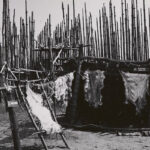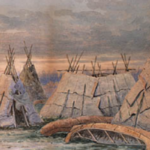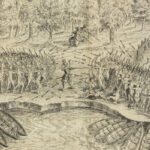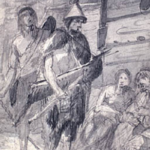Fisher River Cree Nation: A Legacy of Leadership, Resilience, and Cultural Revival
The Fisher River Cree Nation (Ochekwi-Sipi), located along the Fisher River in Manitoba’s Interlake Region, holds a significant place in Canadian history. A part of the Nehiyawak (Cree) people, Fisher River Cree Nation has a rich history of migration, treaty-making, and cultural resilience. The community is renowned for its leadership in preserving Cree traditions, advocating for treaty rights, and fostering a sustainable and vibrant future.
Ancient Origins: The Cree People of the Northern Plains and Boreal Forest
The Fisher River Cree trace their roots to the Swampy Cree (Nehiyawak), a subgroup of the Cree people who have lived in the boreal forest and lowlands of central Canada for over 10,000 years. Known for their adaptability to the dynamic environments of the prairies and forests, the Swampy Cree relied on hunting, fishing, and gathering to sustain their communities. Seasonal migrations were guided by natural cycles, including the movement of game, the spawning of fish, and the growth of wild berries and plants.
The Cree developed intricate knowledge of their environment, which was reflected in their language (Nehiyawêwin) and cultural practices. Their spirituality was deeply connected to the land, with ceremonies and oral traditions emphasizing respect for nature and the interconnectedness of all living beings.
Anthropologist Robin Ridington, in Trail to Heaven: Knowledge and Narrative in a Northern Native Community, notes, “The Cree’s deep relationship with their environment was central to their identity and survival, shaping their worldview and way of life.”
Governance and Social Structure
The Fisher River Cree followed a governance model rooted in consensus and collective well-being. Chiefs and councils were selected for their wisdom, bravery, and ability to lead with fairness and foresight. Elders were integral to decision-making, sharing knowledge and spiritual teachings that had been passed down through generations.
The Cree organized themselves into kinship-based groups, which collaborated to manage resources and maintain social harmony. Seasonal gatherings and ceremonies, such as the Sweat Lodge and Sun Dance, reinforced community bonds and spiritual connections.
Historian Sarah Carter, in Lost Harvests: Prairie Indian Reserve Farmers and Government Policy, observes, “The Cree’s governance systems reflected a balance between autonomy and community responsibility, emphasizing unity within the group and harmony with the land.”
Migration to Fisher River
The Fisher River Cree Nation was established in the aftermath of Canada’s treaty-making process. In 1875, the Cree in the Interlake region became signatories to Treaty 5, which promised land, education, and healthcare in exchange for vast tracts of their territory. Initially, the Cree were settled near Norway House, but flooding and poor conditions in that area led to the relocation of many families to the Fisher River site in 1877.
The move to Fisher River marked a period of adaptation and renewal. The new location provided fertile lands and rich fishing grounds, which allowed the community to re-establish their traditional livelihoods. The Fisher River became a centre for hunting, fishing, and agriculture, reinforcing the Cree’s connection to the land and water.
Historian Margaret Conrad, in A Concise History of Canada, writes, “The relocation of the Fisher River Cree was emblematic of the broader displacements faced by Indigenous communities during Canada’s treaty era, underscoring both the challenges and resilience of these nations.”
The Impact of Residential Schools
Like many other Indigenous communities in Canada, the Fisher River Cree Nation was profoundly affected by the residential school system. Children from Fisher River were forcibly removed from their families and sent to institutions such as the Norway House Residential School, where they were forbidden from speaking Cree or practicing their cultural traditions. The schools sought to assimilate Indigenous children into Euro-Canadian society, often through harsh and abusive methods.
The intergenerational trauma caused by residential schools has had lasting effects on the Fisher River community. Despite these challenges, Fisher River has been a leader in cultural revitalization and efforts to heal from this painful history. Programs aimed at restoring the Cree language (Nehiyawêwin) and traditional practices have played a central role in community recovery.
Resilience and Cultural Revitalization
The Fisher River Cree Nation has demonstrated remarkable resilience in preserving its cultural heritage and addressing the challenges of colonization. The community has taken significant steps to restore traditional ceremonies, oral histories, and the Cree language. Educational programs, cultural workshops, and youth mentorship initiatives ensure that future generations remain connected to their identity.
In recent decades, Fisher River has also been a leader in treaty advocacy. Legal challenges and negotiations have resulted in greater recognition of their rights and increased access to resources, reflecting the community’s commitment to self-determination.
Chief David Crate, in a 2019 interview with CBC News, stated, “Our strength lies in our history and our traditions. By embracing our culture and our treaty rights, we are building a future that honours our past.”
Environmental Stewardship
The Fisher River Cree Nation has long been a steward of the Interlake Region’s ecosystems. Their traditional ecological knowledge guides practices in hunting, fishing, and land management. The community has been proactive in addressing environmental issues, such as the effects of climate change on fish populations and water quality in Lake Winnipeg.
The Fisher River Cree Nation has also invested in renewable energy and sustainable development projects, reflecting their commitment to environmental stewardship. These initiatives not only support the local economy but also align with the Cree’s values of respect and care for the natural world.
Historian Cole Harris, in The Resettlement of British Columbia, writes, “The Fisher River Cree’s approach to environmental stewardship demonstrates their enduring connection to the land and their role as guardians of ecological balance.”
Fisher River Cree Nation Today
Today, the Fisher River Cree Nation is a thriving community with a population of over 3,000 members, many of whom live on reserve. The community blends traditional practices with modern governance and economic development. Investments in housing, education, and healthcare underscore their commitment to self-determination and well-being.
Annual events, such as the Fisher River Powwow, celebrate the community’s heritage and provide opportunities for members and visitors to engage with Cree traditions. Partnerships with universities, environmental organizations, and local governments highlight Fisher River’s innovative approach to reconciliation and sustainability.
A Legacy of Strength and Renewal
The history of the Fisher River Cree Nation is a testament to their resilience, adaptability, and commitment to preserving their cultural heritage. From their migration to the Interlake region and their leadership in treaty-making to their efforts in cultural revitalization and environmental stewardship, the Fisher River Cree Nation has maintained its identity and place within Canada’s evolving landscape.
As Chief David Crate stated, “Our story is one of pride, resilience, and a determination to honour our ancestors while shaping a brighter future for our community.”
References
- Carter, Sarah. Lost Harvests: Prairie Indian Reserve Farmers and Government Policy. McGill-Queen’s University Press, 1990.
- Conrad, Margaret. A Concise History of Canada. Cambridge University Press, 2012.
- Fisher, Robin. Contact and Conflict: Indian-European Relations in British Columbia. UBC Press, 1997.
- Ignace, Marianne and Ronald E. Ignace. Keeping the Stories Alive: Language, Land, and Culture in Indigenous Communities. University of Toronto Press, 2008.
- Harris, Cole. The Resettlement of British Columbia: Essays on Colonialism and Geographical Change. UBC Press, 1997.
- Trigger, Bruce G. Indigenous Peoples of Canada. McGill-Queen’s University Press, 1992.
- Fisher River Cree Nation. Guardians of the Interlake: The History and Culture of Fisher River Cree Nation. Fisher River Publications, 2015.
- Crate, David. “Reclaiming Our Rights: The Future of Fisher River Cree Nation.” CBC News, 2019.
- Treaty 5 Elders. Voices of the North: Stories from Treaty 5 Communities. University of Manitoba Press, 2005.
- Ridington, Robin. Trail to Heaven: Knowledge and Narrative in a Northern Native Community. Douglas & McIntyre, 1988.



